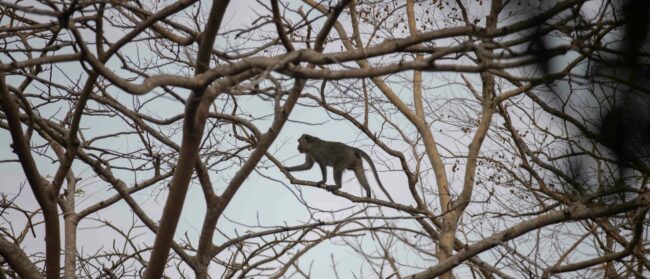Reporters from NTNN/Dan Viet infiltrated and investigated tiger breeding and trading networks across Vietnam and other involved countries. Part one of this story can be read here. Warning: Graphic images
Part 2: Laos, South Africa and Vietnam
Following information from “Tiger T”, a kingpin in the world of tiger bone trafficking in Vietnam’s northeast, we took a trip to Laos to learn about the way to bring tigers back to Vietnam.
For a smooth plan, we asked for contacts of a person named Q in Moc Chau, Son La. After much convincing, Q agreed to let us follow him to Laos, which is considered the capital of “goods from the wild”. There are quite a few tigers brought back to Vietnam through this route.
Tigers butchered before crossing the border
Along the way to Laos, Q kept calling the other border points to check if the stock was still available. After travelling for thousands of kilometres, the group arrived in the Golden Triangle, where the borders of three countries – Thailand, Laos and Myanmar – meet. There is a captive area of more than 20 tigers, 28 bears and many other rare and precious animals such as peacocks, monkeys, and roe deers.
Tourists get free entrance in this area. As for why the owners keep the animals here, no one knows for certain.
Our guide told us to “secretly” rent a tuk tuk driven by a Laotian woman. The dining and shopping district in the Golden Triangle is always vibrant, and was once known for drug-related activities by the infamous Khun Sa tycoon.
Here, we connected with a “big shot” in the market of tiger products. Before that, our group of reporters took photos of people bringing out tiger skin, even tiger meat, bear’s paws and many other wild species on a plastic-pressed menu for customers to choose.
In Laos, we contacted Mr. C who knows very well the cross-border tiger transportation route from Laos to Vietnam.
After a few beers, Mr. C said: “Tigers come from other countries to Vietnam by road through the border. After being transported by car, right before the tigers get to the border, they are slaughtered. The term used by people in this business is ‘palm-leaf raincoat’, which means to remove all the flesh and only transport the skin and bones [like a person wearing a palm-leaf raincoat in the wind].
“Their organs are thrown away, after that, they casually bring the tiger through the border,” he laughed.
Being in this business for a long time, Mr. C knows well that frozen tigers are often full of preservatives.
He said: “You take the tiger’s flesh, throw the tiger’s organs in the pond, and everything in the pond is dead. We found that traders put a lot of chemicals into the skin, bones, and frozen tiger meat. Despite knowing it is poisonous, we still hope it will be alright.
“So, when we take the tiger’s flesh, we can only take the bones. They are full of formalin and chemicals. After boiling the bones, we pour out the water. We keep doing that a few times, by the time we remove the meat from the bones, the meat is already as soft as vermicelli. Tiger meat is sold for 7 million VND/kg [about $303], a tiger that weighs 100kg must cost billions VND. So we need to make sure that they are well-preserved, or else we’ll go bankrupt if anything happens to the meat and the bones!”.
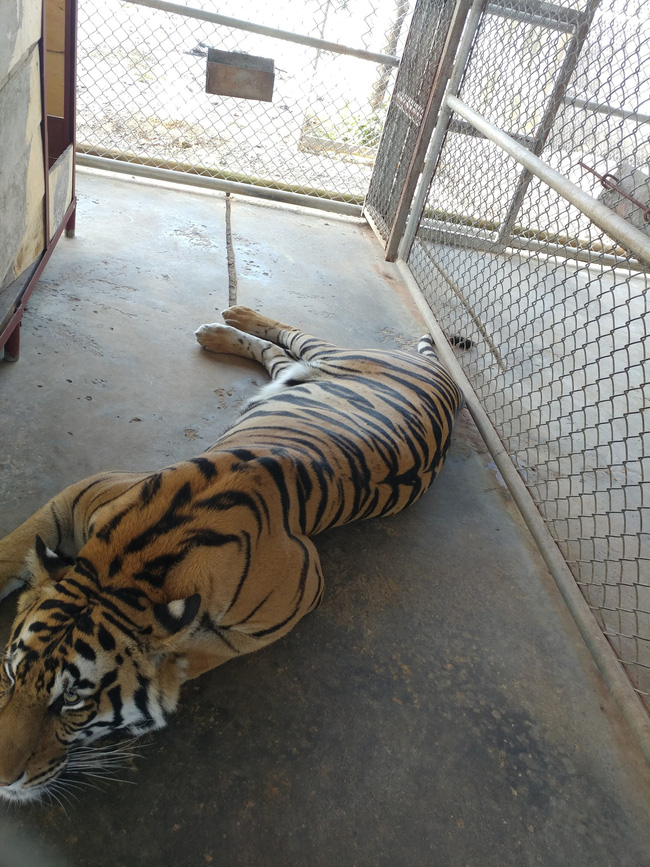
When tiger bones are cooked, they can easily cross the border. An average tiger weighs about 1.5 quintals [150kg], and has around 12% fresh bones [18kg]. Turtle shells, monkey, chamois, and deer bones are also added in the cooking process. In total, the price of tiger bone glue in the black market is 30-40 million VND/tael.
Upon hearing the cheap price of tiger glue, the reporters pretended to be skeptical. Mr. C immediately asserted:
“When we cook tiger bones, we add in monkey bones, and they usually account for more than that of the tigers. That’s how we make profits. The high value comes from the tiger’s leg and head bones. There are extremely thick leg bones that already weigh 2kg, but there are also bones that are too small, too thin. So we have to mix other bones in, or else we suffer losses”.
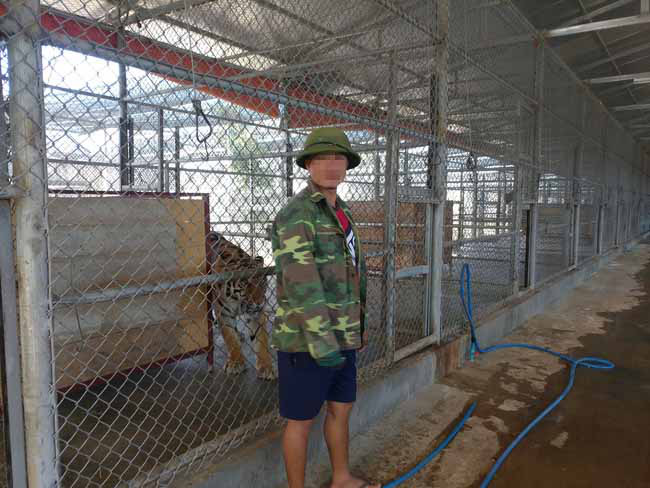
Ways to transfer tiger glue to Vietnam
According to the person specialising in transporting tigers to Vietnam from Laos: “Few border countries do not have forest routes. If we cannot go by the main road, we go via the ‘back door’. But we rarely do that. When you go via the main route a lot, you will know who is on duty for which shift, then you report the time of arrival for the goods, they will check and let you through. As we might be played, sometimes we inform the wrong time of arrival to see what they do”.
I am doing business with a Thai man, he has a tiger farm in Laos where I once visited. He breeds about 12 or 13 tigers. The farm owner injects a dose of anaesthetic and the tiger is fast asleep. People then can do whatever they want with it
Then Mr. C interjected, giving an example. “There was this man who bought a tiger for more than 1 billion dong. He drove a 16-seat Hyundai Starex. He also brought three similar cars with the same number plate, so no one could tell which one carried the tiger. The cars were customised to carry special goods. After receiving the tiger, the owner quietly opened the door, and the car arrived. Everyone was eager to see what’s inside. The driver pressed a button and the car floor was lifted. There was a hidden space under, where it kept the newly purchased tiger!”.
Mr. C continued: “I am doing business with a Thai man, he has a tiger farm in Laos where I once visited. He breeds about 12 or 13 tigers. It was really easy to get in. The farm owner injects a dose of anaesthetic and the tiger is fast asleep. People then can do whatever they want with it”.
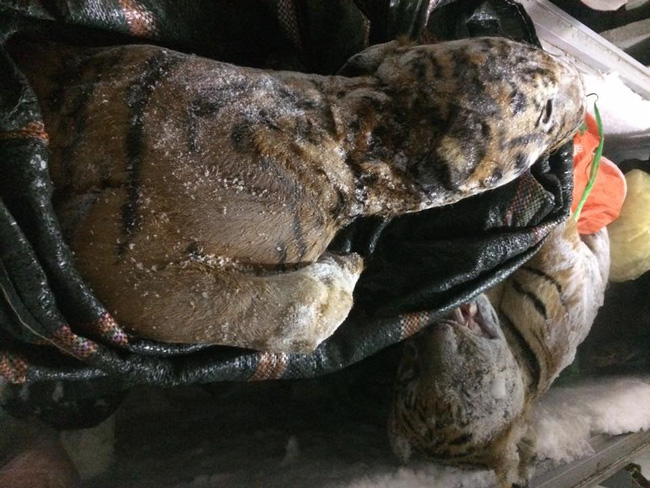
In many large farms, the owners leave the tigers there for decades, and once they return the tigers are almost 100% wild.
“When we saw the tiger again, they injected it with anaesthetic to sell. They found out that the tiger’s fang was long and golden. This kind of ‘product’ is extremely rare, as it is not much different from a wild tiger,” Mr. C said.
Q and Mr. C’s way of trading, buying and selling wild animals, and transporting tigers, is multifaceted. Sometimes they trade in markets, butchers, or hide a freshly-shot deer or a chamois under the floor. There are also people who keep bear paws in the fridge.
As for tigers, the transaction is very confidential, and of course, tigers are the most profitable. Everything is confidential, and the cars keeping frozen animals run across the country trading goods between Laos and Vietnam.
A bitter truth from Africa
We took our reporting further afield to South Africa. We were introduced to a notorious “big shot” of Vietnamese origin to see in person how people breed tigers and turn them into prey. There are also lions that are mercilessly killed here to be made into an expensive product – bone glue.
The host and the staff are from the Vietnamese Northern Central region. Some of the people in the group sitting with us have relatives coming to South Africa to work, the rest staying here to do business – and they have found a way to make money with this thousand-hectare “nature reserve”.
In the midst of the vast savannas, we see groups after groups of wild animals as though it’s the migration season – deer, kudu, birds, and animals with sharp horns. Rhinos run wild like invincible warriors. But what captured our attention the most were the tigers locked up in a cage.
Africa is the land of lions, but there are no wild tigers. How did tigers arrive at this giant farm? As it turns out, according to our reporters, they brought tigers from other places, even from Asia halfway across the world, to breed them like pigs.
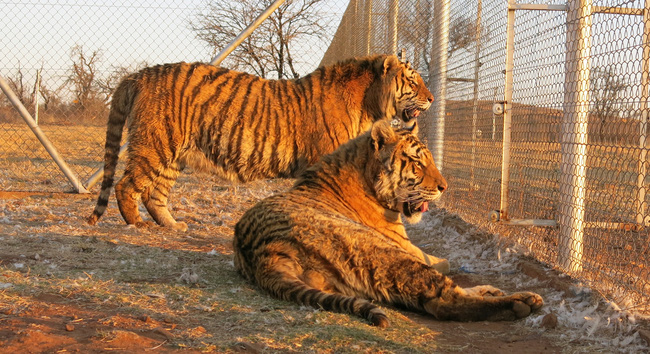
“What do you guys breed tigers for?” I ask H – a pickup truck driver who has just shown me the safari. “For people who want to go hunting?”
While replying, H told a young African girl to cut the penis of a chamois that had just been shot to grill. It turns out that there is a sport hunting service, with customers coming from Europe, America, Asia. They all have two things in common: they are wealthy and have a passion for sport hunting.
“The cost to hunt tigers or lions is about $12,000 each time. I prefer European and American customers. With Asians, it is less profitable, because after shooting tigers, they will ask for their bones to cook bone glue. When Americans and Europeans finish shooting, they will simply go for a drink then head home. We will then collect the tigers and lions’ bodies for bone glue cooking!” H said.
In order to excite the hunters and the killing “game” of these customers, they always provoke the animal to become aggressive. As it frantically escapes after being released from its cage, the hunters sit on all-terrain vehicles, carry large guns, have a guide and bait, and they will hunt and shoot the animals.
“However, the jungle is tens of thousands of hectares wide. If we let lions and tigers out, it would be impossible. The trick is to inject tigers and lions with a dose of sleeping pills. It will slow down after an hour or two running and wait to be shot,” H said.
Vietnamese citizens arrested by South African police at the end of 2018 as part of the lion and tiger bone trade include: Nguyen Huu Son, 30 years old; Nguyen Van Tuan, 33 years old; Dao The Thanh, 38 years old; Pham Van Khue, 56 years old; Chanh, 56, and Cu Quoc Thang, 60; along with two South African nationals. They were indicted after admitting to killing 40 lions to cook in two days. The network is so big that police confessed, despite a long investigation, they couldn’t confirm exactly how many lions were killed by this group.
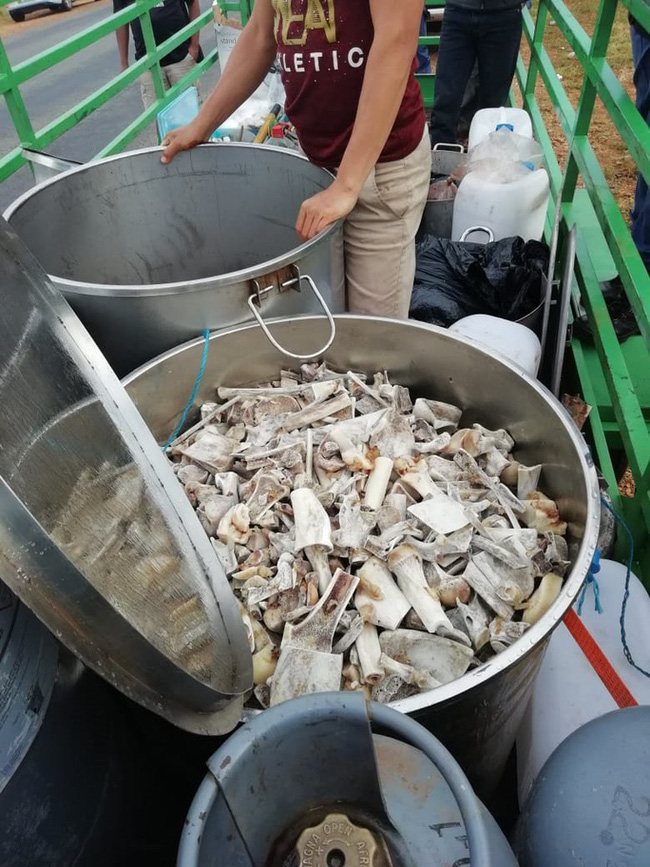
Tigers are imprisoned and fed with rotten chickens
At the tiger farm, everyday they collect dead chickens, rotten chicken wings, and heads to feed tigers. Those are dead chickens from farms, and they are injected with poisonous chemicals.
The animal caretaker said the feathers lying around show how well the tigers have been eating. We also saw baby tigers and lions – rare and precious wild animals are bred like pigs, fed daily with rotten food.
A tiger trafficker called T who transports the animals transnationally to Vietnam revealed: “Only by feeding them with cheap junk food can we make profits. And, traders always try to deceive Vietnamese people by cooking lion bones, and then advertise that they’re tigers. They also bring lion bones back to Vietnam to sell at the price of tigers – despite there being a huge difference in the black market price between these two kinds of bones. Tigers are way more expensive than lions.”
In fact, neither tiger bones nor lion bones are nutritious as rumour has it. Especially tigers and lions that are bred in farms, and fed with dead chickens.
I tell customs officers that I’m bringing jelly back as gifts for people in my hometown. Vietnamese people love jelly. Foreigners can hardly imagine people cooking tiger and lion bones into jelly to eat together
“How do you bring tiger bones, lion bones and their bone glue back to Vietnam? How can you go through hours of flights, many days at sea, and pass security checks with modern machinery and police dogs?” we asked T.
He replied with confidence: “I tell customs officers that I’m bringing jelly back as gifts for people in my hometown. Vietnamese people love jelly. Foreigners can hardly imagine people cooking tiger and lion bones into jelly to eat together.”
For a long time this trick has helped them pass Vietnamese wildlife trafficking agencies.
An interview with Bui Thi Ha, Education for Nature – Vietnam
In order to further clarify legal issues surrounding tiger trade as well as their products, we interviewed Bui Thi Ha – deputy director of Education for Nature – Vietnam (ENV).
ENV is a unit that has spent many years researching, investigating and cooperating closely with authorities in handling wildlife violations in general, and tigers in particular.
Ha stated: “Tiger trading is an on-going complex matter. In 2019 alone, ENV recorded nearly 30 arrests related to tiger trade. That is not to mention hundreds of cases of advertising and trading tiger products on social networking sites such as Facebook and Zalo that the NTNN Newspaper have just been informed of.”
In a series of articles published by the NTNN Newspaper, traders were extremely cunning in bypassing police and using technology and social media to trade tiger goods. Is this situation persisting due to the lack of law enforcement or because of the lax policy?
Currently, Vietnam basically has legal documents to manage and handle violations related to tigers. Hunting, killing, confining, transporting, trading or possessing tigers, products or parts that cannot be separated from the tiger’s life are criminal offenses and may be prosecuted with a penalty of up to 15 years in prison.
Perhaps many people don’t know that trading a tiger’s claw can be prosecuted and offenders sentenced up to five years in prison. Or seemingly very minor violations, such as advertising tiger bone glue on the internet, can also be fined from 70-100 million VND.
Of course, these legal documents are not exactly comprehensive, but according to the ENV’s assessment, the current documents are sufficient to be able to strictly handle tiger-related violations. The problem here is law enforcement and ensuring effective enforcement to prevent these crimes.
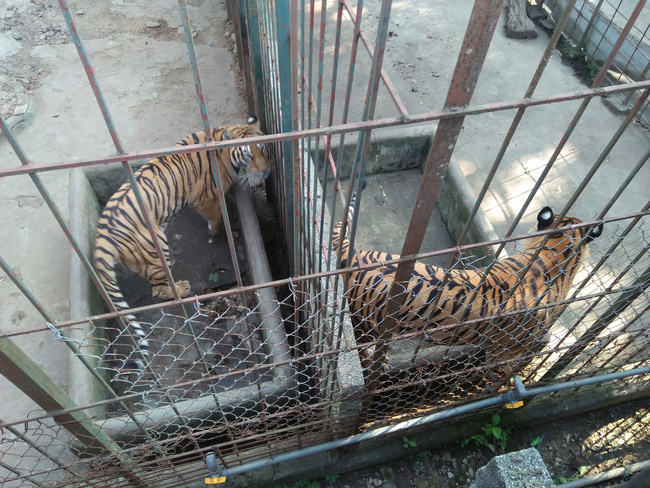
For example, when we coordinate with authorities to detect and arrest an illegal tiger trader, the authorities should not focus solely on this person, but they need to expand the investigation to track down and punish the entire network.
The handling of suspects also requires strict imprisonment to prevent offenders from committing the crime again. Or when it is discovered that a trader sells tiger skin and claws on the internet, although that person does not directly own the product, they should still be fined for their advertisements of banned goods.
How do you evaluate wildlife conservation in general and tiger conservation in particular in Vietnam, from policy to reality?
Tiger conservation is a work of special interest to the State. We have a National Tiger Conservation Program for the period of 2014-2022, approved by the Prime Minister in 2014. In addition, the State has built a system of legal documents on wildlife protection management in general, and tigers in particular.
However, while the regulations on handling violations are quite comprehensive, the regulations on management are still overlapping in terms of authority, and some matters are not yet comprehensively regulated or fully guided. For example, it is not clear for what purpose we are allowed to breed tigers? Is it only allowed to breed tigers for conservation purposes, or can tigers be bred for educational purposes, ecotourism, circus performances and even commercial purposes?
What solutions do we need to limit overlaps in management?
According to ENV, there should be clear regulations for each endangered, precious and rare wildlife species, such as tigers, for what purposes they can be bred. In particular, there should be clear regulations on not allowing endangered, precious and rare species such as tigers to be bred for commercial purposes, and at the same time specifying conditions for tiger farming in non-commercial conservation facilities.
We should not only pay attention to the registration of facilities’, but we should also have a mechanism to check and control the operation of facilities after their establishment. Authorities should ensure that tiger reproduction is only allowed for conservation purposes or other non-commercial purposes when the establishment has a specific breeding plan approved by the State and maintains female tigers, avoiding inbreeding or crossbreeding.
One of the goals of the National Tiger Conservation Program is to “strengthen the management and supervision of tiger farming activities”. Can you elaborate on the purpose of this programme? Should we attach monitor chips on tigers like on bears?
To accomplish this goal, an activity has been set up to record the management of all tigers being bred in Vietnam; establish a national database system to manage and identify captive tigers (through genetic profiles, pictures, electronic chips and tagging).
The Ministry of Agriculture and Rural Development has also studied and discussed with donors in the past the implementation of this, but it has not been done so yet.
Regarding attaching chips on tigers, in ENV’s point of view, it is a good practice to establish identity systems for tigers and endangered, precious and rare wildlife species. However, this activity is only really meaningful if it is accompanied by a full and regular inspection and supervision mechanism of local authorities.
Currently, there are more than 300 tigers in captivity in more than 20 establishments nationwide. In my opinion, there is a need for a mechanism to control the number of tigers bred at these facilities, because it is not feasible to attach chips regularly to newborn tigers considering the reproductive characteristics of tigers. Meanwhile, tigers are born with no conservation value without the participation of science and through conservation programmes approved by the State.
This article was originally published in Vietnamese on Dan Viet here and here and here, and translated into English for the Globe with the permission of the authors. It was the first place winner in the VIEWS journalism awards by CHANGE NGO.

